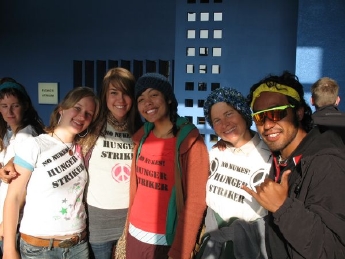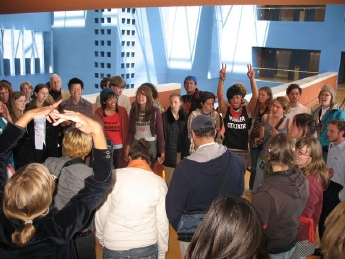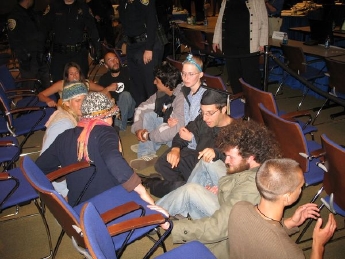|
Online Exclusive
|
|
The No Nukes Hunger Strike: Reflections on the Fast for a Nuclear-Free UC
From May 9-17, 2007, more than 40 individuals at four University of California campuses conducted the "No More Nukes In Our Name!" Hunger Strike. Through this act of protest and personal sacrifice, they demanded that the UC Board of Regents withdraw their management of the US government's two foremost nuclear weapons facilities - the Los Alamos National Laboratory (LANL) in New Mexico and the Lawrence Livermore National Laboratory (LLNL) in the San Francisco Bay Area. The UC has nominally overseen these labs since their inception. As the US government’s largest nuclear warhead contractor for over six decades, the university has provided a much-needed veneer of academic legitimacy to the creation of the world’s most destructive weapons. At the time of the hunger strike, this long-salient issue had taken on an added urgency due to Livermore's design of the Reliable Replacement Warhead, with which the US wants to modernize its entire arsenal. Before embarking on this nine-day fast, a group of us at Berkeley considered whether or not this hunger strike followed the wisdom of Gandhi's “five laws of fasting.” Through his experience, Gandhi found that fasting is successful when it's conducted by a person who has the necessary self-control and the respect of her community, and as a last resort in a larger campaign that is grounded in nonviolent means (and therefore consistent with the nonviolent action of fasting). The demands should be possible to meet and focused on an official or group that cares about the faster. As students, we were credible members of the UC community, and the UC administration (including the Regents) generally cares a great deal about student welfare. The five-year campaign by the Coalition to Demilitarize the UC had been nonviolent, and had tried many nonviolent approaches to persuading the Regents. Our demand—that the Regents debate a resolution to sever ties with the labs––was entirely feasible. In the Berkeley group, many of us had studied principled nonviolence. So in solidarity with the strikers on other campuses, we undertook the fast less to coerce the Regents, and more to witness Truth. Jason Ahmadi from Berkeley said, “We approached this struggle as not only an attempt to make a stand against the university’s production of nuclear weapons, but to bring about a positive change in ourselves through the fast. In essence, we were cleansing both ourselves and the Regents in one simple action.” In addition to the Truth of spiritual purification, we sought to embody a holistic critique of what is really happening in our university and society. Will Parrish, UC Santa Cruz alumnus and one of the key organizers of the hunger strike, said, “Despite many onlookers’ perceptions to the contrary, the hunger strikers’ critique of UC weapons lab management runs much deeper than any particular US policy or program. Opposing UC weapons lab management is a matter of proactively addressing a tangible, very significant manifestation of a global, imperialist system predicated on extreme violence. For others, it is a signpost of the continued––and increasing ––corporatization and militarization of the UC, an institution that purports to (but, in reality, doesn’t and never did) serve the public interest. For still others, their concerns are rooted in the destruction nuclear weapons cause to indigenous people, who are more affected by contamination from the nuclear industry than others.” Indeed, another aspect of Truth in our fast was the way we sought to witness our interdependence as members of a university that is hurting specific communities and the world through its policies. For example, I have long been heartbroken over the radioactive contamination from Area G, and nuclear waste dump at Los Alamos that is poisoning the Rio Grande river and the San Ildefonso Pueblo in New Mexico. Instead of accepting this as an “externality” of my university's weapons research, I took on the suffering of hunger in order to identify with those who are physically suffering from the UC's nuclear industry. This kind of principled nonviolent power may explain why, toward the beginning of the fast, a remarkable paradox began to manifest. In an era when students are generally absorbed in their own studies and survival, many students who were new to the issue jumped onboard and undertook an unusually taxing form of activism: fasting during finals week. In the words of one UC Santa Cruz organizer, “At the teach-in today kicking off the hunger strike for UCSC, I saw faces I hadn't seen in meetings for months or longer, others I'd seen at protests but never at meetings, and still a few more that I'd never seen before in my life. People were coming out of the woodwork to support or join this action.” I believe this spontaneous growth happened because students are looking for a way to meaningfully respond––in this case through self-sacrifice––to the issues that face our world. Whitney Walberg from UC Santa Barbara reflected, “More than anything, the strike gave me hope for the future. I was reminded of the power of the people, the power in me. With enough heart we really will make changes, but the struggle has only begun in my life, and I am glad to join.” Other students unexpectedly joined in the nonviolent struggle during the Regents’ meeting on the last day of the fast. Thirteen students were arrested for obstructing the meeting after the Regents refused to discuss our resolution. Although the Berkeley group had not planned to risk arrest, the power of our cohesion and trust at the meeting prompted our whole group to sit-in to halt the meeting. Walberg describes this nourishing power of community as she experienced it on another campus: “Though I had just met most of the people involved, I felt like they knew me better than most, because they know that feeling I have, the feeling that tells me we have to do something about this.” Matthew Taylor, one of the Berkeley arrestees, has shown how this action was an attempt to hold the Regents accountable for their stated desire to administer good public service and peace in the world: “With love in my heart for the Regents on a personal level, I nonviolently refused to leave the meeting space when ordered to do so by the Regents… Ironically, one of the Regents––before refusing to consider our proposal and ordering us out of the building––stated that he was sympathetic to the goal of nuclear weapon abolition and cited a recent Wall Street Journal op-ed on the subject written by George Schultz, William Perry, Henry Kissinger, and Sam Nunn.” In line with this widely acknowledged “good” of nuclear weapon abolition, Taylor has written an open letter to the San Francisco District Attorney to explain why he refuses to accept community service in lieu of a traditional form of punishment: “I can imagine few more significant forms of community service than actions aimed at the abolition of nuclear weapons… If, however, you believe that there is anything legitimate at all about the existence of nuclear weapons, and if you believe that the University of California, a 'public' institution of 'higher learning' should be managing nuclear weapons development, then I believe you have no choice but to attempt to prosecute and punish me for my actions, given the tragically flawed nature of our dysfunctional retributive justice system.” Our action at the Regents meeting surely was a form of community service, however small its contribution to the larger movement. Our fast did not achieve UC nuclear weapons lab severance. However, it marked what might prove to be a historic turning point in the campaign to end the UC's nuclear ties. Part of the power of a hunger strike is the way it can garner support from the community and inspire future creative actions in the movement. The hunger strike has fostered new and exciting projects including: renewed efforts by UC faculty members to scrutinize and oppose the weapons labs, a UC alumni funding boycott campaign, and new channels of communication between student demilitarization activists and certain members of the Regents. Additionally, the nonviolent resistance at the Regents meeting was featured in a strongly sympathetic light by numerous prominent media outlets, including: the Los Angeles Times, the San Francisco Chronicle, and Democracy Now! The “No Nukes In Our Name!” Hunger Strike stands as an example of action that both empowers individuals and links them to a larger community effort, even if it doesn't immediately accomplish its stated goals. Nonviolence requires persistence and staying power in order to prove effective in the long-term. In the meantime, we still can relish the unexpected. As Walberg said, “I have to say I felt more nourished than ever, despite the lack of food. The hunger strike fed my soul!” |
|
Resources:
|



